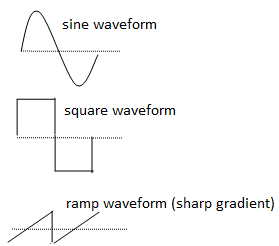Select the correct answers in each of the following options:
(1). AC system is preferred to DC system because,
- AC voltage can be easily changed in magnitude
- DC motor angular velocity is effected badly
- High Voltage AC transmission is less efficient
- Domestic appliances require AC voltage for their operation
Explanation: AC system has a number of advantages over DC system including the power loss which is less in AC system. High voltage is transmitted through transmission lines which reduces the current. This reduces the power loss. Change in voltage is one of the important reasons for preferring AC system.
(2). A capacitor is perfectly insulator for
| (a). Direct Current | (b). Alternating current | (c). Direct as well as alternating current | (d). none |
(3). The peak value of alternating current is 5√2. The mean square value of the current will be
| (a) 5A | (b) 2.5 A | (c) 5√2 A | (d) 52A |
Solution: We know that Irms = Im/√2. Put values, Irms = (5√2/√2) = 5 A
(4) In choke coil the reactance XL and resistance R are
| (a) XL = R | (b) XL ≪ R | (c) XL ≫ R | (d) XL = infinity |
Explanation: An inductive choke is a coil that possesses high inductance XL and very small resistance R and can control AC without any loss of energy.
(5) In an RLC circuit the capacitance is made one-fourth, when in resonance. Then what should be change in inductance, so that the circuit remains in resonance?
| (a) 4 times | (b) ¼ times | (c) 8 times | (d) 2 times |
Solution: Condition for resonance is XC = XL = 1/ω c
Now when the capacitance is reduced to one-fourth, the new capacitance is c’ = c/4. Put in the above equation to new find XL’.

Thus the inductance should be increased by 4.
(6) In AC system we generate sine wave form because
- It can be easily drawn
- It produces least disturbance in electrical circuit
- It is natural standard
- Other waves cannot be produced easily
Explanation: A waveform is the representation of the variation of the alternating current with time. This variation in current may be brought through a number of ways, for example, sine, square or ramp. However, a sine wave changes more smoothly and produces less disturbance in the circuit.

(7) The phase difference between current and voltage at resonance is
| (a) 0 | (b) π | (c) -π | π/2 |
Explanation: While in resonance, the inductive and capacitive reactance are equal and opposite, so they cancel each other. Therefore, the current and voltage remain to be in the same phase. See resonance curve comprehensive question 11.
(8) An alternating voltage is given by 20 sin157t. The frequency of the alternating voltage is
| (a) 50 Hz | (b) 25 Hz | (c) 100 Hz | (d) 75 Hz |
Solution: We have, V = Vmsinωt = Vmsin2πft. Compare with the given equation
2πf = 157 OR f = 157/2π OR f = 157/2*3.14 OR f = 157/6.28 = 25 Hz
(9) In RL circuit which one of the following statement is correct?
- L and R opposes each other
- R value increases with frequency
- The inductive reactance increases with frequency
- The inductive reactance decreases with frequency
Explanation: XL = ω L = 2πfL. Therefore, the inductive reactance XL increases with increasing the frequency.
(10) An alternating quantity (voltage and current) is completely known if we know its
| (a) Maximum value | (b) Frequency and phase | (c) Effective value | (d) Both a and b |
Explanation: As an example the alternating sinusoidal voltage is given by
V = Vm sinωt = Vmsin2πft. Here, Vm is the maximum value of the sinusoidal voltage, f is the frequency and t is the time (which determines the phase). Therefore, we can completely describe the alternating quantity (voltage in this case) if we know its maximum value in the curve, its frequency and phase.
(11) For electromagnetic waves, Maxwell generalized
(a) Gauss’s law for magnetism (b) Gauss’s law for electricity
(c) Faraday’s law (d) Ampere’s law
(12) An electromagnetic wave goes from air to glass which of the following does not change?
| (a) Wavelength | (b) Speed | (c) Frequency | (d) All of these |
Explanation: When the electromagnetic wave goes from one medium to another, its speed changes at the cost of wavelength. Frequency depends upon the oscillation of the source emitting the wave and does not change.
(13) Which of the following radiation is different from the others
| (a) Radio waves | (b) X-rays | (c) Ultraviolet radiation | (d) Ultrasound waves |
(14) The circuit in which current and voltage are in phase, the power factor is
| (a) zero | (b) 1 | (c) -1 | (d) 2 |

Pingback:sq-ch5-p12 – msa
Pingback:solved-numerical-problems-alternating-current-circuit-physics-12-msa – msa
Pingback:lq-ch-15-p12 – msa
Plz I need know
I want conceptual question’s solution of chapter physics of solids
Hasib Khan
Sure. We will upload it on priority basis. Please check now and then.
Pingback:Physics 12 – msa
Pingback:Numerical Problem 10, AC Circuit, Physics 12 … msa – msa
Pingback:numerical-problem-1-alternating-current-physics-12-msa – msa